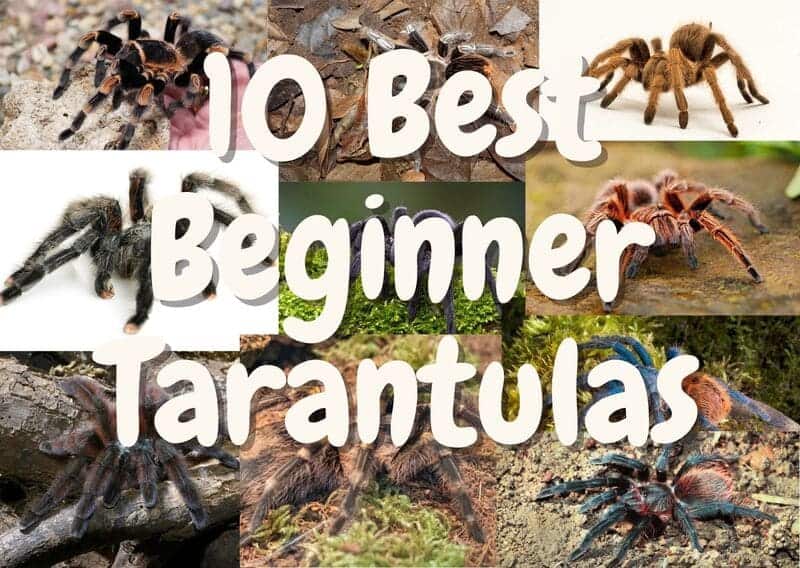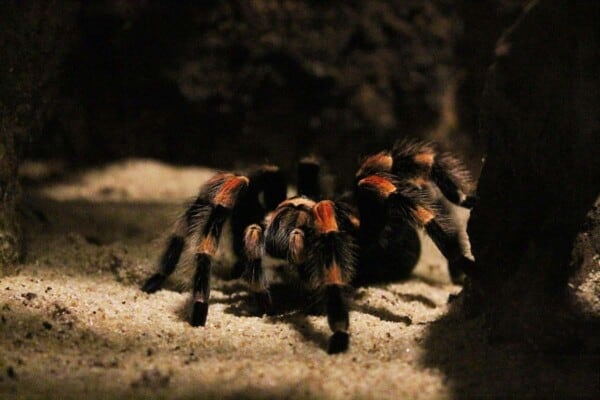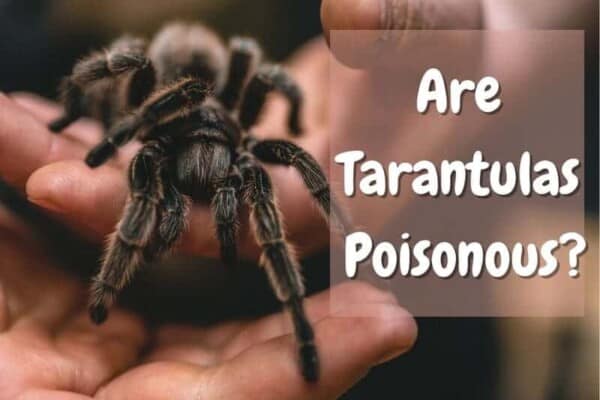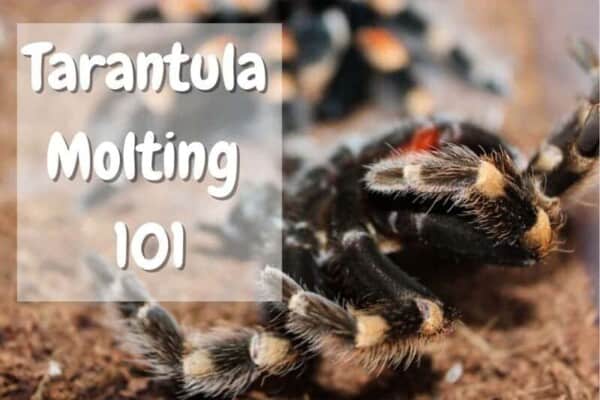What are the best beginner tarantulas on the market? With around 850 species of Tarantulas around the world and new species being discovered on a regular basis in the heart of the Amazon forest, you could say that you are spoiled for choice. However, not all species are a good option for a first-time tarantula owner.
The 10 best tarantulas species for beginners are:
- Chilean Rose
- Arizona Blonde
- Pink Toe
- Mexican Red Knee
- Costa Rican Zebra
- Brazilian Black
- Antilles Pinktoe
- Chaco Golden knee
- Mexican Red Rump
- Green Bottle Blue
In this post, we will take a closer look at these five tarantula species a complete novice will be most comfortable with, mainly due to their low-maintenance profile and their docile nature. Without further ado, let’s get to know the 10 winners.
10 Best Beginner Tarantulas Overview
| Name | Scientific Name | Dwelling | Lifespan (Male/Female) | Size | Price |
|---|---|---|---|---|---|
| 1- Chilean Rose | Grammostola rosea | Terrestrial | 7 years/ 20 years | 5.5″ | $20-25 |
| 2- Palomino Blonde | Aphonopelma chalcodes | Terrestrial | 10 years / 20 years | 5.5″ | $35-45 |
| 3- Pink Toe | Avicularia avicularia | Arboreal | 3 years / 10 years | 5″ | $25-30 |
| 4- Mexican Red Knee | Brachypelma Smithi | Terrestrial | 10 years / 30 years | 5-6″ | $40-130 |
| 5- Costa Rican Zebra | Aphonopelma Seemanni | Terrestrial | 3 years / 18 years | 4.5″ | $30-35 |
| 6- Brazilian Black | Grammostola Pulchra | Terrestrial | 8 years / 30 years | 7″ | $100 |
| 7- Antilles Pink Toe | Caribena Versicolor | Arboreal | 5 years / 12 years | 5-6″ | $85-95 |
| 8- Chaco Golden Knee | Grammostola pulchripes | Terrestrial | 10 years / 25 years | 7″ | $35-65 |
| 9- Mexican Red Rump | Tliltocatl vagans | Terrestrial | 5 years / 25 years | 6.5″ | $25-30 |
| 10- Green Bottle Blue | Chromatopelma cyaneopubescens | Terrestrial | 4 years / 14 years | 6″ | $60-80 |
1- Chilean Rose Tarantula
On top of the list of the best beginner tarantulas is the Chilean Rose tarantula, which is from Northern Chile and also lives in Argentina and Bolivia. You can identify a Chilean Rose tarantula by its predominantly dark brown body with reddish-pink hair all over it.

- Temperament: What makes the Chilean Rose one of the best beginner tarantulas is its calm and docile temper. If they become upset, their rear legs will go up, and if they feel threatened, they will flick their urticating hair. They are not known to be aggressive, but if provoked and handled poorly, they might bite.
- Leg Span: A fully-grown tarantula has an average leg span of 5 1/2 inches.
- Lifespan: Female tarantulas have a lifespan of up to 20 years whereas male tarantulas have a lifespan of up to 7 years.
- Habitat: You should house them in a 5 to 10-gallon terrarium that is 2 to 3 times wider than their leg span. You need to use 2 inches of substrate for the bedding. The recommended substrates include sandy sanitary soil, vermiculite, peat moss, and orchid bark. Give them privacy by adding a hollow log into the terrarium. You don’t need to invest in a separate heat source as the natural lighting will do just fine. You need to keep the temperature between 75 to 85 degrees Fahrenheit with a humidity of 60% to 70%. If you want, you can add a small heat rock to keep track of the terrarium’s humidity level.
- Diet: You can feed them live food such as brown crickets, black crickets, and locusts. You can also place a shallow water dish and add pebbles inside to prevent the spider from drowning.
- Price: The price range for the Chilean rose tarantula is around $20-25, which makes it one of the cheapest beginner tarantulas.
2- Arizona Blonde Tarantula
The Arizona Blonde tarantula, (aka Desert Blonde and Palomino Blonde) is found in Mexico, Arizona, and California. You can tell it’s an Arizona Blonde by the exotic blonde color on its body and lower legs, along with black hair on its femurs and brown hair on its abdomen.
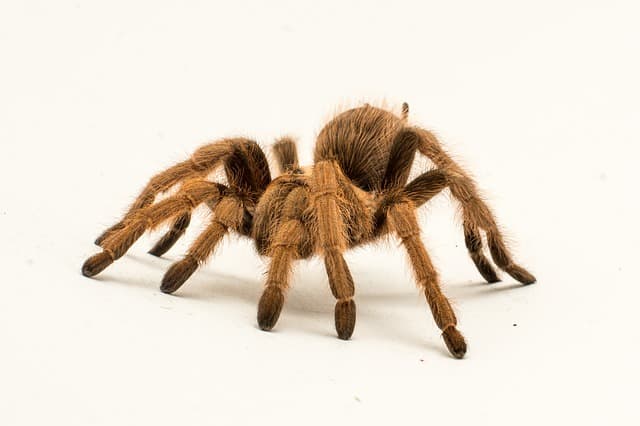
- Temperament: These spiders are excellent beginner tarantulas thanks to their mild temper – actually, it is one of the most commonly used tarantulas in the Hollywood industry due to their gentle nature. However, they occasionally have mood swings, and messing with them will cause them to raise their two front legs (their biting stance). They will also flick their urticating hairs if they sense a threat.
- Leg Span: A fully-grown tarantula has a leg span of 5 1/2 inches.
- Lifespan: Female Arizona Blonde tarantulas can live up to 30 years, making them one of the longest-living species. Male tarantulas can live up to 10 years.
- Habitat: You should buy a 5-gallon terrarium without a mesh top as these spiders are climbers and can get their legs caught up in it. Get at least 3 inches of substrate for their bedding. Some recommended substrate includes soil, peat moss, and vermiculite. You can add a cork bark into the terrarium, so they can crawl inside and hide. You need to keep the temperature between 75 to 80 degrees Fahrenheit with humidity levels between 65% and 70%. You don’t need to invest in any heating sources. If the temperature of your house tends to drop lower than the recommended temperature, you’ll need to invest in a small portable heater for the room.
- Diet: You can feed them live food such as crickets, locusts, super worms, and cockroaches. You can add either a flat water dish or a shallow water dish. If you’ve selected a shallow water dish, place rocks to prevent drowning.
Price: You can buy an Arizona Blonde for about $35 – 45.
3- Pink Toe Tarantula
The Pink Toe tarantula hails from South America. You can identify it’s a Pink Toe tarantula by its pinkish-orange toes and hairy black legs.
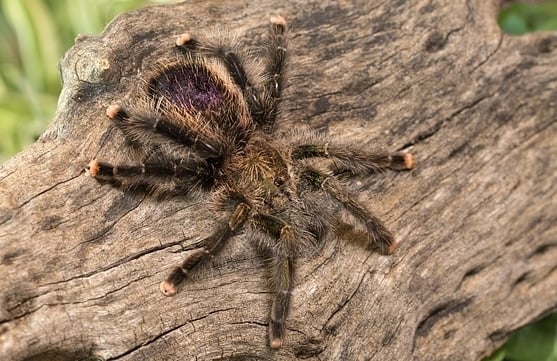
- Temperament: They are generally tame and don’t bite, but will flick their urticating hairs towards a target if feel threatened. Try not to make them nervous or scared because you’ll not like the nasty surprise they dish out — spraying feces. Otherwise, they are extremely calm, docile, and non-aggressive species that keep to themselves. They move fast, so don’t let them escape.
- Leg Span: A fully-grown Pink Toe tarantula has a leg span of 5 inches.
- Lifespan: On the lower spectrum of lifespan, female Pink Toe tarantulas have a lifespan of up to 10 years, whereas males have a lifespan of up to 3 years.
- Habitat: You can keep them in a 5 to 10-gallon terrarium. You should line the bottom of the terrarium with a 2 to 3-inch substrate. Some popular substrates include potting soil, sphagnum peat moss, fir, and coconut husk. The temperature of the room containing the spider’s terrarium should be between 74 and 85 degrees Fahrenheit with a humidity level of 75% to 82%. Since these spiders prefer high levels of humidity, you can spray water on the substrate each day. However, it can result in mold growth, which can kill your spider, so keep an eye out for it. You can use a fluorescent bulb to view in the daytime, but it isn’t necessary. If you choose to go with a fluorescent bulb, ensure it stays on for 8 to 10 hours, and then turn it off to allow them to sleep in the dark.
- Diet: You can feed live food to your Pink Toe once a week or once every two weeks. Other live food to give them include cockroaches, super worms, and mealworms. You can treat them occasionally with pinkie mice, wax worms, and hornworms. You should place a shallow water bowl for tarantulas with a leg span of at least 3 inches. Replace their water with clean water each day. Since this spider prefers high humidity levels, keeping a shallow water bowl can increase and maintain the humidity levels.
- Price: The price of a Pink Toe is around $25-30.
4- Mexican Red Knee Tarantula
The Mexican Red Knee tarantula lives in the semi-desert land of Mexico and Panama. You can identify it’s a Mexican Red Knee by its black abdomen and few strands of red hair and black legs with red, tan, and orange stripes.
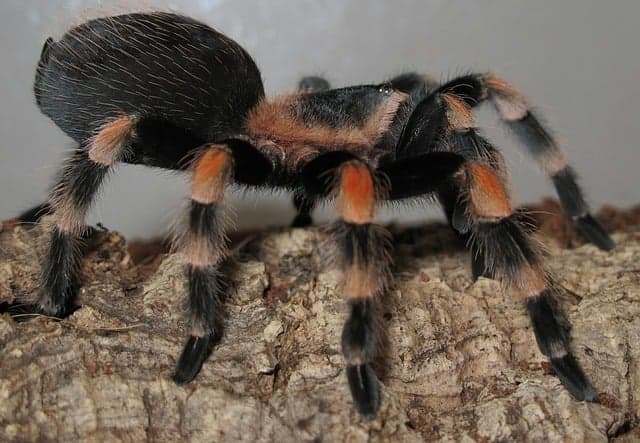
- Temperament: They aren’t biters, but runners, which makes it a little bit more challenging to keep, but still among the best beginner tarantulas. Like the other species, they will flick urticating hairs if threatened.
- Leg Span: A fully-grown Mexican Red-Knee tarantula has a leg span between 5 to 6 inches.
- Lifespan: Female Mexican Red-Knee can live up to 30 years whereas a male can live up to 10 years.
- Habitat: You should buy a 5 to 10-gallon terrarium with a width two to three times wider than the tarantula’s leg span. For the bedding, buy sphagnum peat, vermiculite, coir peat, and sphagnum moss. These bedding choices help balance the humidity levels and help your spider during the molting process. We recommend that you combine the different types of substrates together such as moss, peat, and vermiculite to retain enough moisture without it becoming too damp.
Even though this tarantula likes to burrow in the sand, you should avoid placing sand in its terrarium, as it can block its book lungs and result in death. However, you don’t have to deprive them of their favorite pastime. Instead of sand, use a shallow, 2 to 3-inch, substrate with cork bark, laid horizontally on top of it. However, with a shallow substrate, extra care is needed to ensure no décor falls into it. Use low-level lighting and keep the temperature between 69 to 78 degrees Fahrenheit with a relative humidity of between 40% to 60%.
- Diet: You can feed them live crickets, mealworms, locusts, cockroaches, and for larger species, Morio worms, placing one at a time. You should feed them one to three times each week.
- Price: The price ranges from $40 to $130, depending on their age and where you buy them.
5- Costa Rican Zebra Tarantula
Number 5 on our “best beginner tarantulas” list is the Costa Rican Zebra tarantula from Costa Rica and Central America. You can identify it’s a Costa Rican Zebra tarantula by its black abdomen with white stripes on its legs.
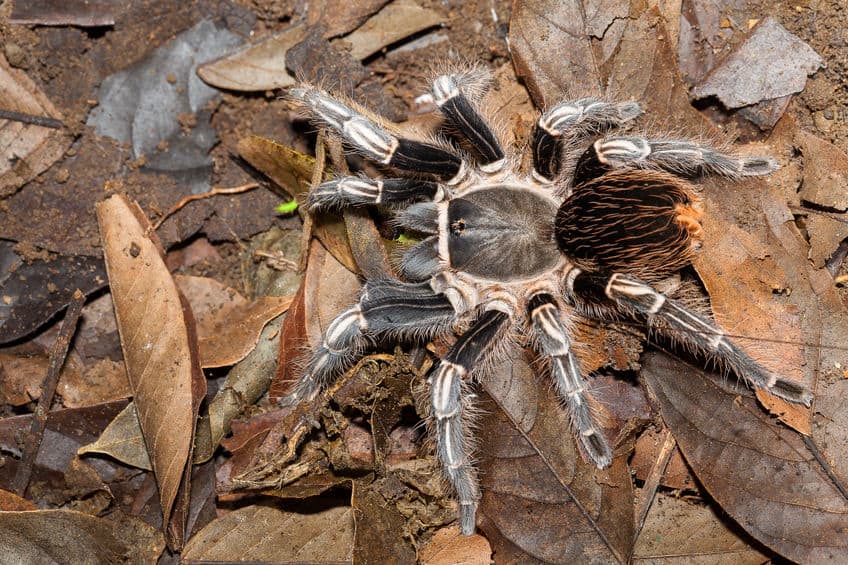
- Temperament: Even though these spiders are relatively calm and quiet, they are extremely skittish. They also move very fast, making them harder to catch in the event they escape. Regularly handling the spider can tame it. If threatened, they will flick their urticating hairs at their target.
- Leg Span: Smaller than many species, a fully-grown tarantula has a leg span of 4.5 inches.
- Lifespan: Female tarantulas have a lifespan of up to 18 years whereas male tarantulas have a lifespan of up to 3 years.
- Habitat: You should keep them in a 5 to 8-gallon terrarium. For the bedding, consider a thick substrate, as they are burrowers. You should place at least 4 inches thick substrate at the bottom of the substrate made of soil, peat moss, or vermiculite. You can also add a log or cork bark to the terrarium, which your spider will use when it wants to reflect on its life. The temperature of the room you house your spider’s terrarium needs to be between 70 to 85 degrees Fahrenheit with a humidity level of 75% to 80%. You will not need to buy an additional heat source unless you reside in a colder region of the country or you like to keep your home cool.
- Diet: You can feed your spider live food such as crickets, feeding it once a week. You can add a water bowl, changing the water each day.
- Price: The price is around $30-35.
6- Brazilian Black Tarantula
Your average Brazilian Black is soft and velvety jet black with even hairs all over its body. There are also some bluish-to-grey highlights at the tip of the legs. Obviously, its abdomen and legs have a metallic blue sheen and chocolate brown shades.
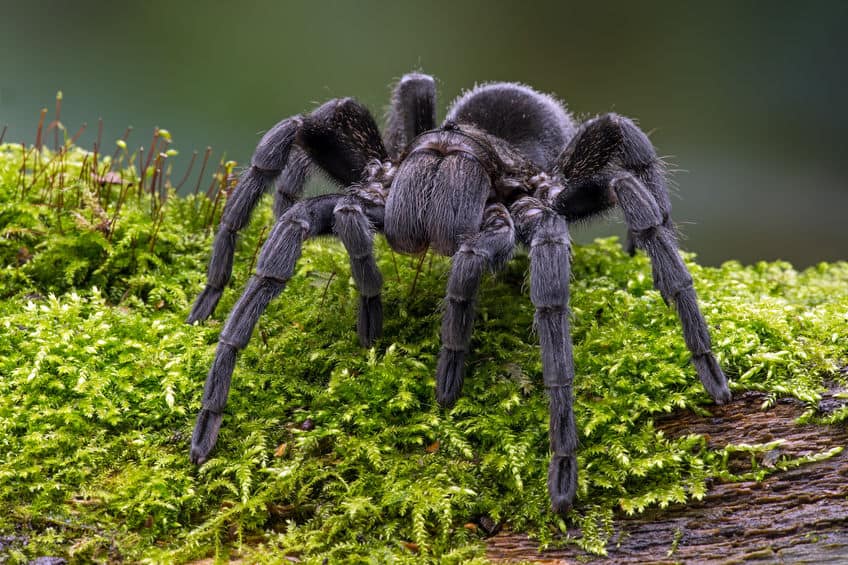
- Temperament: This big black spider is very easygoing, but among some of the bigger tarantula enthusiasts, they feel this is one of the best and friendliest. It just comes down to how much you handle them so keep them docile.
- Leg span: The leg span is often 6-7 inches and not any longer than that.
- Lifespan: The winner here is the adult female who can live up to 30 years, while males live just 8 years.
- Habitat: You can get away with a 5 to 10-gallon tank to keep your tarantula. They’ll prefer to roam around, so have a lid cover that doesn’t allow them to escape. As for burrowing into their substrate, females need 3-4 inches, while males like deeper burrows up to 8 inches. Mix coconut fiber and moss with sterile soil that isn’t overly moist. As for something they can hide inside, these big spiders will enjoy ceramic containers. If they can’t find anything they like, they’ll prefer to burrow. The temperature can be 75-85F degrees with no more than 60-70% humidity within their tank. If the night temperature dips lower than this, you’ll need to install a heating pad under the tank.
- Diet: These big beasts of the spider world will enjoy larger prey of 5 locusts per week. You can choose pinky mice and small lizards too. Large moths will be a good choice since this tarantula likes to hunt at night. As for their drinking cap, use a Snapple cap or pickle jar lids.
- Price: Because these spiders grow to be so large, the slings can have a starting cost of $100 and up.
7- Antilles Pink Toe Tarantula
The Antilles Pinktoe tarantula is a very colorful spider. You might see variants that have vivid rosy-red and electric blue highlights. There is another version that can appear to be metallic green with plenty of purple-looking highlights. They can even have bright red abdomens or striped patterns forming ornate designs.
You just never know what color the carapace will be in the end though since these can become bluish-green or iridescent green with blue, and even versions of chocolate.
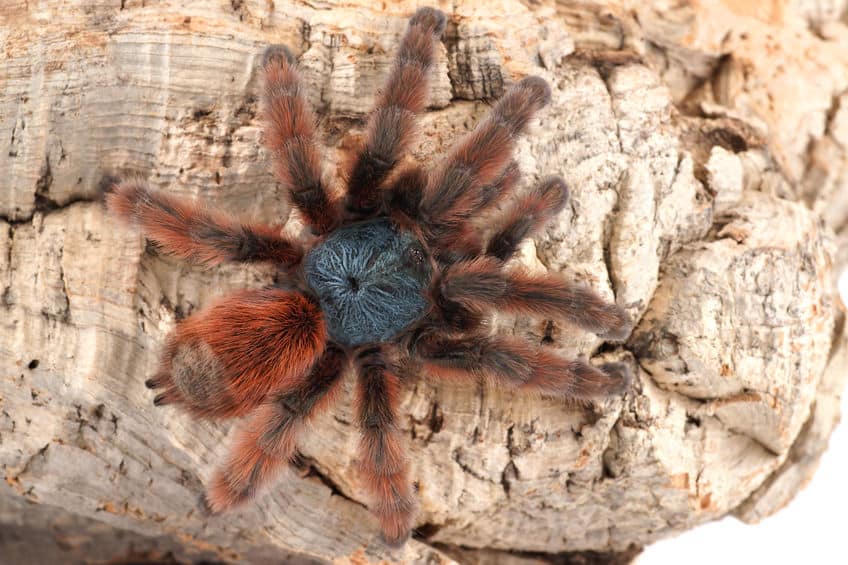
- Temperament: This species is touchy if you aren’t paying attention. They especially don’t like to be spooked and like to jump to avoid confrontation. They will also like to flick their urticating hairs. Some owners have experienced having sticky feces flung at them. There is a slight chance they could bite if pushed too far.
- Leg span: Adult females have a modest legs pan of 6 inches.
- Lifespan: Females that are fully grown will live only 12 years, while males can live just 3 to 5 years.
- Habitat: Any adult Antilles Pink Toe will enjoy a tank no bigger than 5 gallons. They also need a tank that has added ventilation holes to have circulating air. This species is arboreal so they will like a tree-like branch they can climb into. Be sure the lid is very secure because of this. Their substrate needs to be at least 2 inches deep but not overly moist with very low levels of moisture within the peat moss, sterile soil, and vermiculite mixture. The temperature needs to be 80-20F degrees with upwards of 80-90% humidity. You’ll certainly need a heating pad and spray bottle to keep this setting just right.
- Diet: Adults will enjoy 2 or 3 crickets, dubia roaches, and grasshoppers as a steady diet per week. As for water, these smaller spiders will like an aspirin-sized cap up to a Snapple-cap size to get a drink.
- Price: The price of these slings will be pricey, starting at $85-90. They are difficult to breed, hence their higher cost.
8- Chaco Golden Knee Tarantula
These impressive beauties that come from Argentina and Paraguay are an overall dark brown tarantula. The upper legs along the body are often dark black followed by rich orange hair emerging at the initial exoskeleton joint. The rest of the abdomen and legs are tipped with light orange or pink hairs.
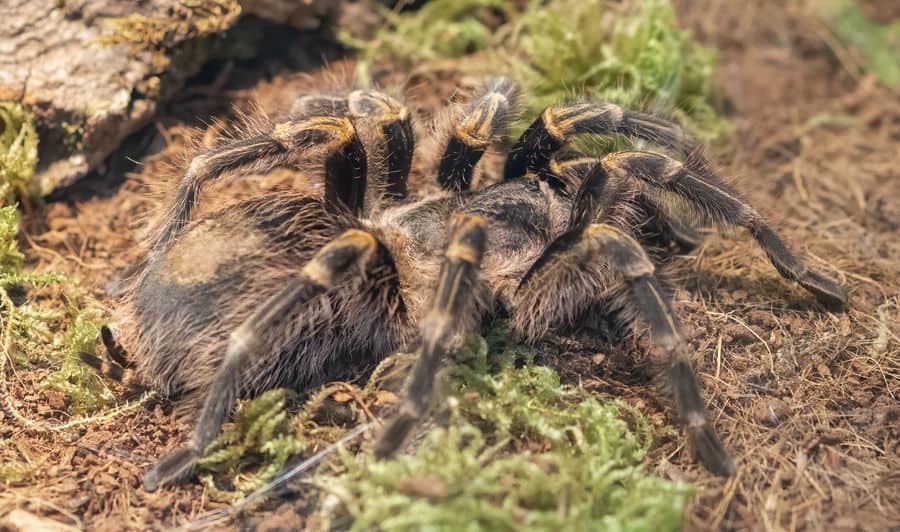
- Temperament: One of the best abilities of the Chaco Golden Knee is that it remains calm and docile most of the time. It likes to be lazy outside its burrow most of the day, making this an ideal show-off pet. Despite this species having very large fangs, it will not be prone to bite. It doesn’t like sudden movements and will flick its urticating hairs at you when it becomes irritated.
- Leg span: You can expect an adult to have a leg span of 7 inches.
- Lifespan: Adult males live 5 to 10 years, while fully grown females can live 20 to 25 years.
- Habitat: This species will enjoy a tank that is at least 15 gallons but keep in mind that because their leg span is so wide, the width of your tank also needs to be twice as wide. Their substrate needs to be 6 inches deep which is a combination of coconut fiber and chemical-free compost that is sterile. They will like to find their shelter inside a hidey house or a portion of sterile bark as a private shelter. They’ll enjoy a tank temperature around 70-75F degrees with at least 50-60% humidity.
- Diet: They’ll love to eat a couple of B. dubia roaches, and around 7 crickets per week. Their water dish should be sunken into the substrate so they can get a drink when they want.
- Price: You can expect spiderlings to cost $35-65, but some private sellers are asking upwards of $85-100 bucks if you aren’t checking around.
9- Mexican Red Rump Tarantula
The Mexican Red Rump comes from Central America and has an overall black body with black legs. The abdomen has vivid bright red setae that stand out.
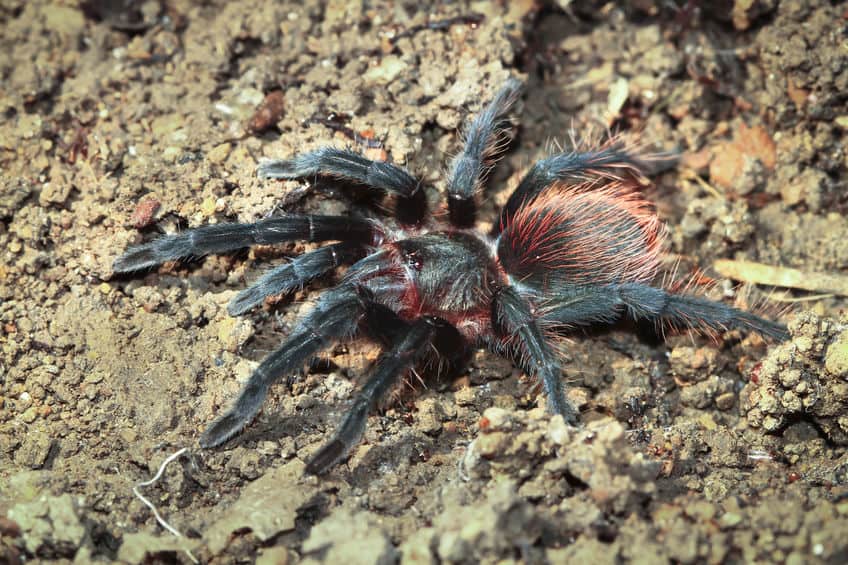
- Temperament: Often these tarantulas are pretty docile and easygoing unless you irritate them or surprise them. They’ll often flick their abdomen hairs at you. They’ll especially be on guard if you try to change their water, so you can offer them a cricket to throw them off.
- Leg span: The average leg span is 6.5 inches for most females.
- Lifespan: A female that is fully grown is living up to 25 years, but males rarely reach 5 years.
- Habitat: Any 5-gallon aquarium is good for this tarantula breed. It likes to roam around and isn’t really a climber, so try to avoid anything they can fall from. Their substrate needs to be slightly damp so they can burrow. They’ll do this often, so expect that they’ll change burrows pretty often. Have a mixture that is loose-packed sterile soil with some coconut fiber, peat moss, and vermiculite. It needs to be at least 5-10 inches deep, so your tank needs to be pretty tall. They will also enjoy hiding spots that are upturned ceramic covers or cork bark hideouts. The temperature needs to be 75-80F degrees continually with a drop to 70F degrees at night. This is because they like to hunt at night when it’s cooler. You also need to have 65-80% humidity which should also be lower at night.
- Diet: An adult will consume up to 7 crickets per week with 2 large dubia roaches in between. They are ferocious eaters and like to hunt their prey.
- Price: This tarantula isn’t very costly and will average $25-30 per sling.
10- Green Bottle Blue Tarantula
The Green Bottle Blue tarantula is an easy one to spot due to its blue legs, green carapace, and orange-rust colored setae on its abdomen. This import from Northern Venezuela also has dark-tipped feet and rusty setae hairs over much of their legs.
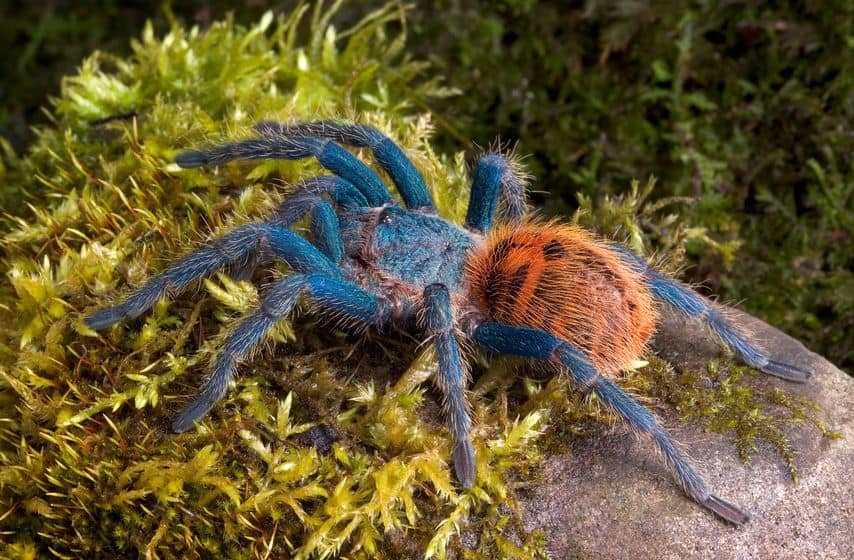
- Temperament: Just on the first appearance, your green bottle blue will look docile and easygoing. They can be very skittish at times if you aren’t being extra careful approaching them directly. They’ll be prone to flick urticating hairs at you additionally. They also like to bolt if you make sudden movements. But aside from that, they make excellent terrarium pets since they’ll sit out all day.
- Leg span: Their leg span will reach up to 6 inches or slightly larger by one-quarter inch.
- Lifespan: Females can live up to 14 years while the males only live to be 4 years tops.
- Habitat: These terrestrial spiders like a tank that is 5 gallons but nothing larger than that. They will need a temperature no higher than 70-80F degrees in the day and 65 to 75F degrees at night. This is when they like to hunt, so this needs to be regulated. Humidity should be drier at 30-50% all through the year. So making a 50/50 mixture of peat moss and sphagnum moss is a great choice. They aren’t really into burrowing so they like to cover the substrate with thick layers of silk. Be sure to give them hiding places such as ceramic skulls, or broken pottery for their housing.
- Diet: Give adults crickets, grasshoppers, and small B. dubia roaches. They won’t mind eating an occasional super worm, which will be a real treat for them.
- Price: This breed can cost between $60-80 depending on the breeder.
Related Articles
- 12 Best tarantula terarriums
- 300+ Cool and funny names for a tarantula
- How to set up a tarantula terrarium in 7 steps
Contents
- 10 Best Beginner Tarantulas Overview
- 1- Chilean Rose Tarantula
- 2- Arizona Blonde Tarantula
- 3- Pink Toe Tarantula
- 4- Mexican Red Knee Tarantula
- 5- Costa Rican Zebra Tarantula
- 6- Brazilian Black Tarantula
- 7- Antilles Pink Toe Tarantula
- 8- Chaco Golden Knee Tarantula
- 9- Mexican Red Rump Tarantula
- 10- Green Bottle Blue Tarantula

